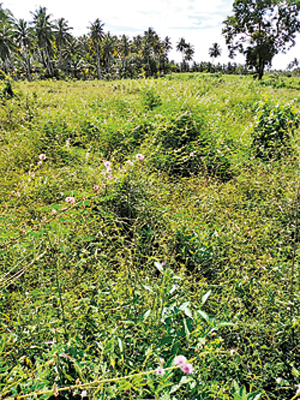Have you seen this invader?

Under threat: An area overgrown with the plant in Chilaw. Pic by Indika Samarasinghe
A novel invasive plant in Sri Lanka, “Giant sensitive plant” (Mimosa diplotricha), is reported to have already established in some parts of the Puttalam District.
This species is related to the well-known ‘Nidi-kumba’ or Sensitive plant (Mimosa pudica), which is frequently seen as a weedy creeping herb, especially in the low country wet zone of Sri Lanka. Another member of the same group (Mimosa) is the notorious ‘Giant Mimosa’ (Mimosa pigra), a large thorny shrub that has been introduced here several decades ago and is now considered as a troublesome invasive plant in Sri Lanka.
The new alien invasive weed, Mimosa diplotricha was first reported by Deputy Director of the Provincial Department of Agriculture in Puttalam Ms. Tharangani Shyamali early this month. This news was conveyed to me by Assistant Director, Department of Agriculture, Peradeniya, Sanath Bandara, who had advised her to seek my assistance to identify this strange invader. She also arranged Agricultural Instructor Indika Samarasinghe, to assist me and he visited the location in suburban Chilaw and provided me with detailed information, including several photographs. The plant was initially identified as Mimosa diplotricha and for confirmation I sent a botanical description and the images of the plant to Missouri Botanical Garden, USA. The confirmation was immediately received.
The ‘Giant sensitive plant’ is a scrambling shrub reaching to about 2 metres, but capable of climbing to some heights if supports such as fences and low shrubs are available. Stems and leaves are viciously spiny, a common characteristic of the Mimosa group. Leaves are sensitive to touch, twice divided (bipinnate) with a feathery appearance, each primary segment (pinna) with about 20 pairs of small secondary segments (pinnules). When mature, stems produce nearly spherical and pink flower-heads which look like clustered fluffy balls, almost like in ‘Nidi-kumba’. Seed pods are shortly spiny, elongated and produced in clusters, each with 4 to 5 seeds.
According to initial information, the plant has been observed in populations in Chilaw, Anamaduwa and Madurankuliya in the Puttalam District. The natural range of the ‘Giant sensitive plant’ is tropical and subtropical America (South and Central America including the Caribbean). However, it has been introduced in the African, Asian and Australian continents, most often as a cover crop which has escaped and now grown to invasive proportions. It is generally considered a troublesome and noxious invasive weed. In Asia, it has already established in Cambodia, Thailand and India, especially in the states of Assam and Kerala, where it is known as ‘Anathottawadi’.
In Sri Lanka, therefore, it will be urgently necessary for the agricultural authorities to launch intensive awareness programmes, especially in already affected areas, areas that are vulnerable to become invaded and generally throughout the island. School education will be very effective in this regard. Intensive control of the weed initially involving uprooting, grubbing and burning is recommended. This process should be repeated every six months until the disappearance of the weed. Assistance of the Plant Protection Services of the Department of Agriculture will be necessary.
(The writer is a former Director, Plant Genetic Resources Centre, Department of Agriculture)


